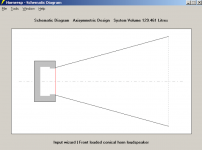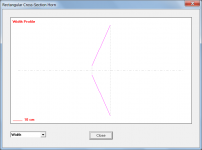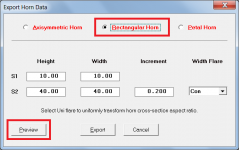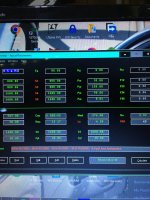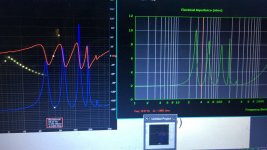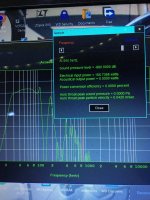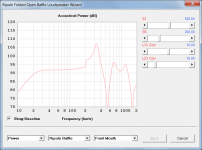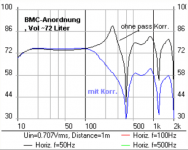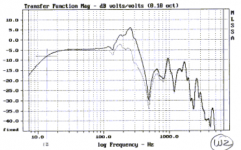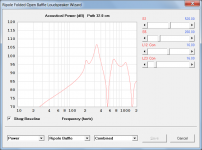It is up to you to choose the cross-sectional shape for the actual horn you wish to build. Just keep the cross-sectional areas the same as those used in the simulation.
You are indeed the bug smasher of all times David. Polishing this jewel of a program. I never caught that problem before. But I can see how it could cause trouble.
Thanks - so I can build the throat and mouth areas and just connect them, in this case, with plane sides?It is up to you to choose the cross-sectional shape for the actual horn you wish to build. Just keep the cross-sectional areas the same as those used in the simulation.
//
so I can build the throat and mouth areas and just connect them, in this case, with plane sides?
Only when the conical horn has square cross-sections at the throat and mouth, or when the cross-sections at the throat and mouth are rectangular and have identical aspect ratios.
Otherwise, if two opposing sides are plane, then the other two will need to be curved to retain the overall conical area expansion rate.
To illustrate the above, if S1 = 100, S2 = 1600 and L12(Con) = 20, and if the throat is square (10 H x 10 W) and the mouth is rectangular (eg 16 H x 100 W) then the sides of the conical horn will be as shown in the attachments.
Attachments
Hi Mark,I never caught that problem before. But I can see how it could cause trouble.
I only picked it up by sheer chance myself 🙂.
It was not so much a bug in that it was doing what was intended - it was more of an oversight on my part, which is why I classified it as a CHANGE rather than a BUG in the update post. Like you, I felt that it could cause trouble if the user did not realise that the Vel or Acc setting had been carried forward, which is why I decided that it would be better to reset it to the default Eg in the new Input Wizard record.
Kind regards,
David
OK, I understand. I also see the Height and Width options in your pictures but don't seem to have them on my computer.... what am I doing wrong? Rectangular Cross Section - how do I view that?Only when the conical horn has square cross-sections at the throat and mouth, or when the cross-sections at the throat and mouth are rectangular and have identical aspect ratios.
Otherwise, if two opposing sides are plane, then the other two will need to be curved to retain the overall conical area expansion rate.
To illustrate the above, if S1 = 100, S2 = 1600 and L12(Con) = 20, and if the throat is square (10 H x 10 W) and the mouth is rectangular (eg 16 H x 100 W) then the sides of the conical horn will be as shown in the attachments.
I will need to read up "a bit" also in general. Thanks!
//
I also see the Height and Width options in your pictures but don't seem to have them on my computer.... what am I doing wrong? Rectangular Cross Section - how do I view that?
1. Select the File > Export > Horn Data... menu commands from the Schematic Diagram window, as shown in Attachment 1.
2. Select the Rectangular Horn option, set the Height and Width dimensions and then click the Preview button, as shown in Attachment 2.
It's all explained in the Export Horn Data section of the Help file 🙂.
Attachments
Greets!
Me n' math.........🙁 The total length of each ND65 is the same 90.40 cm, so why does the LW list 90.50 cm?
Since these were made from a 0606 rev TL master of sorts, took just a driver from a many revs older file (0002 of 2994) to input a quickie TL comparison from scratch and it too is 10 cm too long, so at least consistent if this is even a suitable comparison. 😉
Me n' math.........🙁 The total length of each ND65 is the same 90.40 cm, so why does the LW list 90.50 cm?
Since these were made from a 0606 rev TL master of sorts, took just a driver from a many revs older file (0002 of 2994) to input a quickie TL comparison from scratch and it too is 10 cm too long, so at least consistent if this is even a suitable comparison. 😉
Attachments
Hi GM,
A great pickup - thanks!
The bug would have been there for ages. I am a bit surprised that no one, myself included, did not notice it earlier...
Just to show how easily these things can happen, the statement:
If L34 < 0.1 Then L34 = 0.1
Should be:
If L34 > 0 And L34 < 0.1 Then L34 = 0.1
In your examples L34 = 0 but because L34 < 0.1 Hornresp is setting L34 = 0.1 and adding it to the overall length of the horn 🙂.
The bug will be fixed in the next update. Thanks again for reporting it!
Kind regards,
David
A great pickup - thanks!
The bug would have been there for ages. I am a bit surprised that no one, myself included, did not notice it earlier...
Just to show how easily these things can happen, the statement:
If L34 < 0.1 Then L34 = 0.1
Should be:
If L34 > 0 And L34 < 0.1 Then L34 = 0.1
In your examples L34 = 0 but because L34 < 0.1 Hornresp is setting L34 = 0.1 and adding it to the overall length of the horn 🙂.
The bug will be fixed in the next update. Thanks again for reporting it!
Kind regards,
David
Greets!
You're welcome!
Would probably have never noticed it if I didn't calculate alignments, then input them to make sure I didn't screw up or want to revise them, so initially thought HR was auto correcting a math error on my part and it took me awhile to finally believe it might be an HR error or at least you'd find mine as I really have a problem of not being able to 'see the forest for the trees' with math.
You're welcome!
Would probably have never noticed it if I didn't calculate alignments, then input them to make sure I didn't screw up or want to revise them, so initially thought HR was auto correcting a math error on my part and it took me awhile to finally believe it might be an HR error or at least you'd find mine as I really have a problem of not being able to 'see the forest for the trees' with math.
So does Hornresp sometimes 🙂.I really have a problem of not being able to 'see the forest for the trees' with math.
What would the Best description of the scenario where a horn response is wiping out 😂👍🏻 frequencies from existence? It Makes sense actually.. it’s just describing it in a way that’s very serious about it.
As this frequency (860hz) and then the subsequent frequencies there after also, such as 1720 and 2580 and 3440, and on out all the way… 19870…all with -990 DB and no pressure/velocity And then the next it’s right back up to 40/80/90dB..+ and beyond in the surrounding area with in the very next hz… then repeat..
So it’s very specific and incredibly interesting if you look at what those numbers represent outside of sound and 1/4 wave length based speakers…. Where the heart and soul of economics , astrophysics, I don’t even know what else, they’re pretty important! .. and so they’re really really interesting.
The idea is lining up both sides of the drivers output ‘perfectly’ Which judging by the measured impedance (pic ) and any of the details of the simulation info (50cm2 Sd x4 drivers sim pic) it is absolutely amazing ! the spot on bandwidth and info, details verbatim. It’s almost scary how impressive it is!! 👍🏻
As this frequency (860hz) and then the subsequent frequencies there after also, such as 1720 and 2580 and 3440, and on out all the way… 19870…all with -990 DB and no pressure/velocity And then the next it’s right back up to 40/80/90dB..+ and beyond in the surrounding area with in the very next hz… then repeat..
So it’s very specific and incredibly interesting if you look at what those numbers represent outside of sound and 1/4 wave length based speakers…. Where the heart and soul of economics , astrophysics, I don’t even know what else, they’re pretty important! .. and so they’re really really interesting.
The idea is lining up both sides of the drivers output ‘perfectly’ Which judging by the measured impedance (pic ) and any of the details of the simulation info (50cm2 Sd x4 drivers sim pic) it is absolutely amazing ! the spot on bandwidth and info, details verbatim. It’s almost scary how impressive it is!! 👍🏻
Attachments
Hello David,Hornresp Update 5400-220507
Hi Everyone,
CHANGE
Ripole folded open baffle loudspeaker designs can now be simulated. See the 'Ripole Folded Open Baffle' section in the Help file for details.
The simplest way is to specify a Ripole is to use the Input Wizard to generate a template design and then modify that design as necessary using the Loudspeaker Wizard.
BUG FIX
The inconsistency in results identified in Post #12,688 has now been fixed. My thanks to grindstone for reporting the problem.
Kind regards,
David
Is there a reason why you didn't plot the combined output of the Ripole but rather of one end?
Hi Giri,Is there a reason why you didn't plot the combined output of the Ripole but rather of one end?
I decided to show only the front mouth output so that it could be compared against an AkAbak simulation and set of measured results that I came across, both of which, for whatever reason, only took the one output into account.
I am no expert on Ripole loudspeakers, but it seems to me that because the combined output will be significantly reduced at low frequencies due to the two outputs being out of phase, a practical loudspeaker would need to be positioned and oriented such that the output from the rear was not a significant contributor to the overall response observed by the listener.
Attachment 1 shows the Hornresp front mouth output simulated results.
Attachment 2 shows the AkAbak simulated results.
Attachment 3 shows the measured results.
Attachment 4 shows the Hornresp combined output simulated results.
The dimensions and driver of the Ripole system simulated in Hornresp are not the same as those of the system simulated in AkAbak, and the measured system is different again, but the general characteristics of the three responses are quite similar.
Kind regards,
David
Attachments
Last edited:
Hello David,Hi Giri,
I decided to show only the front mouth output so that it could be compared against an AkAbak simulation and set of measured results that I came across, both of which, for whatever reason, only took the one output into account.
I am no expert on Ripole loudspeakers, but it seems to me that because the combined output will be significantly reduced at low frequencies due to the two outputs being out of phase, a practical loudspeaker would need to be positioned and oriented such that the output from the rear was not a significant contributor to the overall response observed by the listener.
Attachment 1 shows the Hornresp front mouth output simulated results.
Attachment 2 shows the AkAbak simulated results.
Attachment 3 shows the measured results.
Attachment 4 shows the Hornresp combined output simulated results.
The dimensions and driver of the Ripole system simulated in Hornresp are not the same as those of the system simulated in AkAbak, and the measured system is different again, but the general characteristics of the three responses are quite similar.
Kind regards,
David
Which the response the user would more likely experience, the combined or one sided?
Because the combined response looks quite anemic below 80 Hz, which is where a woofer's work actually starts.
Regards,
Giri
Hi Giri,
Kind regards,
David
As I said, I am no expert on Ripole loudspeakers 🙂. I am not sure how they are actually set up and used in practice, hopefully someone with more experience in such matters may be able to comment further.Which the response the user would more likely experience, the combined or one sided?
Agreed. As far as I can see any dipole-type system is going to be significantly compromised at bass frequencies unless one of the outputs is effectively "isolated" from the listener in some way.Because the combined response looks quite anemic below 80 Hz, which is where a woofer's work actually starts.
Kind regards,
David
- Home
- Loudspeakers
- Subwoofers
- Hornresp
